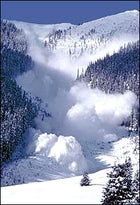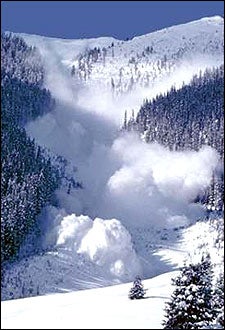You’re poised to launch off a cornice at 9,000 feet in British Columbia’s coast range. Beckoning below is a stadium-sized bowl of fresh powder atop an impressive base. You push off and cut a series of perfect turns, hearing nothing but the swish of your own skis—until the mountain announces itself with a pronounced whoomph. The snow drops a few inches, throwing you off balance, and then hell breaks loose: The massive slab you’re skiing on begins to disintegrate, with you caught dead center. And so begins the most terrifying ride of your life.

RELEASE A crown fracture line marks the point at which a fissure ripped across a slope in excess of 300 mph, unleashing a hard slab avalanche. Simple sunshine, an explosion, or an unwary person hundreds of feet down the mountainside can set the snowpack moving. “The crack splits open like hitting a pane of glass with a hammer,” explains Colorado Avalanche Information Center director Knox Williams.
ACCELERATION Within ten seconds, the slab breaks up and the cascade of snow reaches speeds of 70 to 80 mph—faster than you if you’re caught skiing beneath it. In April 1999, a skier was overtaken and killed by a soft slab avalanche on a slide path near Ophir in southwest Colorado. Forecasters at the state’s Avalanche Information Center judged the slide to be five feet deep and 600 feet across—cloaked in a powder cloud. It plunged 1,200 vertical feet before stopping.
AFTERMATH With their explosive speed and sheer volume of snow, dry slab avalanches often wreak the most havoc, snapping trees, destroying buildings, and flipping vehicles such as a 2.6-ton Ford Expedition. At Peruvian Lodge, in Alta, Utah, a family was inside when the slide hit, but escaped unscathed through the back hatch. Sometimes harm can come even to those beyond an avalanche’s runout zone: Air blasts knock people over, flatten tents, even mow down trees on the opposite side of the valley.
FINE CRYSTAL Snowflakes begin changing as soon as they touch ground. An individual flake loses its arms and collapses in on itself. Falling snow pushing down from above causes some crystals to deform further into rounded grains, which may later grow the facets and telescoping cups of depth hoar. As loose as dry sand, such crystals often constitute the critical weak layer of a slab avalanche.
LOOKING FOR TROUBLE
An avalanche forecaster ferrets out a dangerous weakness in the snowpack with the shovel shear test. He digs a six-foot-deep pit, then wields a snow saw to isolate a foot-wide column in the uphill bank. By inserting a shovel down into the back of this column and pulling, he seeks to simulate the action—on a smaller scale—of the entire slope. The layer at which the column shears off reveals the likely breaking point of a real-life avalanche. The typical culprit: buried surface hoar, or frost that may have formed atop a hard layer such as ice from a brief rainstorm. Deeper layers might yield depth hoar, loose granules that act like ball bearings carrying the full weight of the mass above. Forecasters must dig pits in multiple locations to gain any meaningful insight into the wider slope.
THE DEADLY THREE
Know The Enemy
While no two avalanches are exactly alike, slides can be grouped into a trio of basic types. A loose snow avalanche forms when a small slough gives way and begins moving downhill, picking up snow along the way and spreading laterally across the slope in a characteristic inverted V. Though usually shallow, this type of avalanche can upset a skier’s balance enough to send him tumbling toward downslope hazards such as escarpments. If the snow is wet, its colossal weight can compound the slide’s lethal force.
An ice avalanche is limited to glaciated high-mountain terrain, but on its home turf it’s no less deadly. A large chunk of ice—a serac, for example, or a cornice—breaks free and tumbles down a cliff, exploding in car-size blocks and a huge cloud of dust.
Because of its potential depth, force, and scale, the slab avalanche claims the most victims. In these slides, a broad area of snowpack breaks away and begins moving downhill as a cohesive mass riding over an ice sheet or bare ground. The slab is the worst hazard a skier or snowboarder is likely to encounter. If you’re caught mid-slope, shed your skis and poles, swim for dear life, and pray you end up staring at blue sky when the whole thing comes to a halt.


